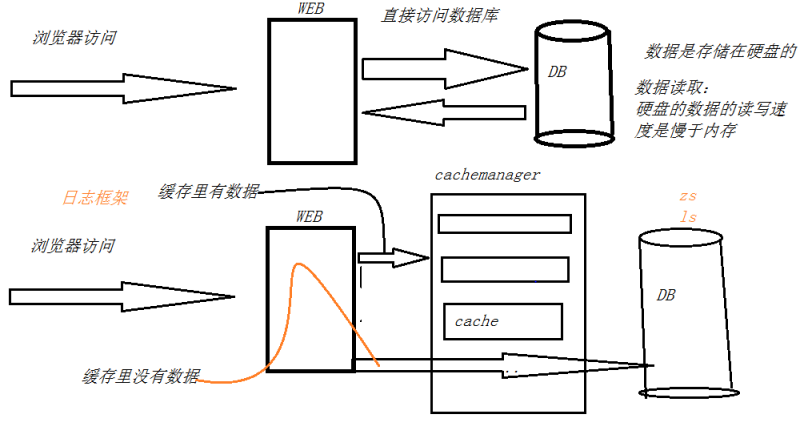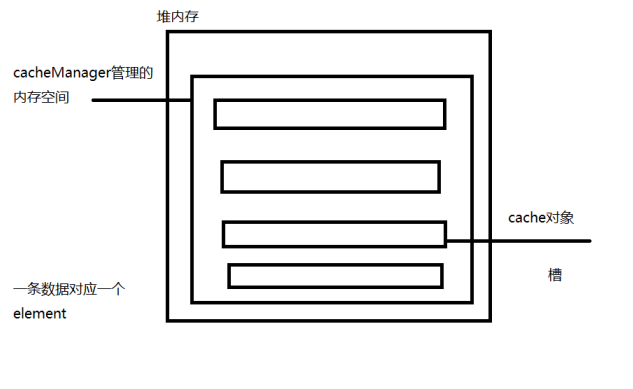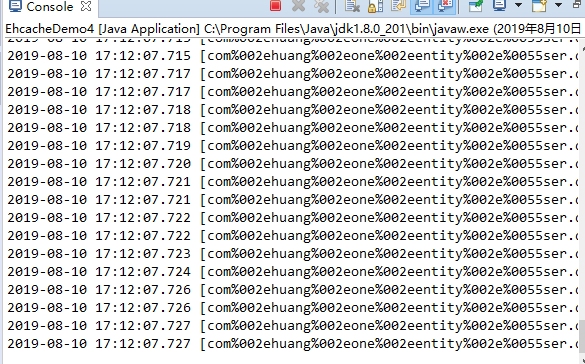hibernate之二级缓存
什么是二级缓存?
Hibernate中的二级缓存,二级缓存是属于SessionFactory级别的缓存机制。
第一级别的缓存是Session级别的缓存,是属于事务范围的缓存,由Hibernate管理,
一般无需进行干预。第二级别的缓存是SessionFactory级别的缓存,是属于进程范围的缓存。
下面是二级缓存使用场景:
1. 为什么需要缓存 拉高程序的性能
关系型数据库:数据与数据之间存在关系(联系)的数据库 mysql/Oracle、sqlserver
非关系型数据库:数据与数据之间是不存在关系的,key-value
1、基于文件存储的数据库:ehcache
2、基于内存存储的数据库:redis、memcache
3、基于文档存储的数据库:mongodb
2. 什么样的数据需要缓存
很少被修改或根本不改的数据 数据字典
业务场景比如:耗时较高的统计分析sql、电话账单查询sql等
3. ehcache介绍
Ehcache 是现在最流行的纯Java开源缓存框架,配置简单、结构清晰、功能强大
注1:本章介绍的是2.X版本,3.x的版本和2.x的版本API差异比较大
redis
4. ehcache的特点
4.1 够快
Ehcache的发行有一段时长了,经过几年的努力和不计其数的性能测试,Ehcache终被设计于large, high concurrency systems.
4.2 够简单
开发者提供的接口非常简单明了,从Ehcache的搭建到运用运行仅仅需要的是你宝贵的几分钟。其实很多开发者都不知道自己用在用Ehcache,Ehcache被广泛的运用于其他的开源项目
4.3 够袖珍
关于这点的特性,官方给了一个很可爱的名字small foot print ,一般Ehcache的发布版本不会到2M,V 2.2.3 才 668KB。
4.4 够轻量
核心程序仅仅依赖slf4j这一个包,没有之一!
4.5 好扩展
Ehcache提供了对大数据的内存和硬盘的存储,最近版本允许多实例、保存对象高灵活性、提供LRU、LFU、FIFO淘汰算法,基础属性支持热配置、支持的插件多
4.6 监听器
缓存管理器监听器 (CacheManagerListener)和 缓存监听器(CacheEvenListener),做一些统计或数据一致性广播挺好用的
4.7 分布式缓存
从Ehcache 1.2开始,支持高性能的分布式缓存,兼具灵活性和扩展性
3. ehcache的使用
3.1 导入相关依赖
<dependency> <groupId>net.sf.ehcache</groupId> <artifactId>ehcache</artifactId> <version>2.10.0</version> </dependency>
3.2 核心接口
CacheManager:缓存管理器
Cache:缓存对象,缓存管理器内可以放置若干cache,存放数据的实质,所有cache都实现了Ehcache接口
Element:单条缓存数据的组成单位

例:
利用map集合简易实现缓存原理
package com.huang.six.test; import java.util.HashMap; import java.util.Map; public class EhcacheDemo1 { static Map<String, Object> cache = new HashMap<String, Object>(); static Object getValue(String key) { Object value = cache.get(key); System.out.println("从内存中读取数据"); if(value == null) { // System.out.println("hello zs"); System.out.println("从数据库中读取数据"); cache.put(key, new String[] {"zs"}); return cache.get(key); } return value; } public static void main(String[] args) { System.out.println(getValue("sname")); System.out.println(getValue("sname")); } }
运行效果:
从内存中读取数据
从数据库中读取数据
[Ljava.lang.String;@7852e922
从内存中读取数据
[Ljava.lang.String;@7852e922
然后用eacache缓存数据、读取数据
package com.huang.six.util; import net.sf.ehcache.Cache; import net.sf.ehcache.CacheManager; import net.sf.ehcache.Element; import java.io.InputStream; public class EhcacheUtil { private static CacheManager cacheManager; static { try { InputStream is = EhcacheUtil.class.getResourceAsStream("/ehcache.xml"); cacheManager = CacheManager.create(is); } catch (Exception e) { throw new RuntimeException(e); } } private EhcacheUtil() { } public static void put(String cacheName, Object key, Object value) { Cache cache = cacheManager.getCache(cacheName); if (null == cache) { //以默认配置添加一个名叫cacheName的Cache cacheManager.addCache(cacheName); cache = cacheManager.getCache(cacheName); } cache.put(new Element(key, value)); } public static Object get(String cacheName, Object key) { Cache cache = cacheManager.getCache(cacheName); Element element = cache.get(key); return null == element ? null : element.getValue(); } public static void remove(String cacheName, Object key) { Cache cache = cacheManager.getCache(cacheName); cache.remove(key); } }
然后我们来使用二级缓存
hibernate(5.2.12.Final)中使用二级缓存步骤(ehcache)
首先我们在pom.xml中导入ehcache相关依赖:
<dependency> <groupId>net.sf.ehcache</groupId> <artifactId>ehcache</artifactId> <version>${ehcache.version}</version> </dependency> <dependency> <groupId>org.hibernate</groupId> <artifactId>hibernate-ehcache</artifactId> <version>${hibernate.version}</version> </dependency> <!-- slf4j核心包 --> <dependency> <groupId>org.slf4j</groupId> <artifactId>slf4j-api</artifactId> <version>${slf4j-api.version}</version> </dependency> <dependency> <groupId>org.slf4j</groupId> <artifactId>jcl-over-slf4j</artifactId> <version>${slf4j-api.version}</version> <scope>runtime</scope> </dependency> <!--用于与slf4j保持桥接 --> <dependency> <groupId>org.apache.logging.log4j</groupId> <artifactId>log4j-slf4j-impl</artifactId> <version>${log4j-api.version}</version> </dependency> <!--核心log4j2jar包 --> <dependency> <groupId>org.apache.logging.log4j</groupId> <artifactId>log4j-api</artifactId> <version>${log4j-api.version}</version> </dependency> <dependency> <groupId>org.apache.logging.log4j</groupId> <artifactId>log4j-core</artifactId> <version>${log4j-api.version}</version> </dependency>
然后在src添加ehcache.xml
<?xml version="1.0" encoding="UTF-8"?> <ehcache xmlns:xsi="http://www.w3.org/2001/XMLSchema-instance" xsi:noNamespaceSchemaLocation="http://ehcache.org/ehcache.xsd" updateCheck="false"> <!--磁盘存储:将缓存中暂时不使用的对象,转移到硬盘,类似于Windows系统的虚拟内存--> <!--path:指定在硬盘上存储对象的路径--> <!--java.io.tmpdir 是默认的临时文件路径。 可以通过如下方式打印出具体的文件路径 System.out.println(System.getProperty("java.io.tmpdir"));--> <diskStore path="D://xxx"/> <!--defaultCache:默认的管理策略--> <!--eternal:设定缓存的elements是否永远不过期。如果为true,则缓存的数据始终有效,如果为false那么还要根据timeToIdleSeconds,timeToLiveSeconds判断--> <!--maxElementsInMemory:在内存中缓存的element的最大数目--> <!--overflowToDisk:如果内存中数据超过内存限制,是否要缓存到磁盘上--> <!--diskPersistent:是否在磁盘上持久化。指重启jvm后,数据是否有效。默认为false--> <!--timeToIdleSeconds:对象空闲时间(单位:秒),指对象在多长时间没有被访问就会失效。只对eternal为false的有效。默认值0,表示一直可以访问--> <!--timeToLiveSeconds:对象存活时间(单位:秒),指对象从创建到失效所需要的时间。只对eternal为false的有效。默认值0,表示一直可以访问--> <!--memoryStoreEvictionPolicy:缓存的3 种清空策略--> <!--FIFO:first in first out (先进先出)--> <!--LFU:Less Frequently Used (最少使用).意思是一直以来最少被使用的。缓存的元素有一个hit 属性,hit 值最小的将会被清出缓存--> <!--LRU:Least Recently Used(最近最少使用). (ehcache 默认值).缓存的元素有一个时间戳,当缓存容量满了,而又需要腾出地方来缓存新的元素的时候,那么现有缓存元素中时间戳离当前时间最远的元素将被清出缓存--> <defaultCache eternal="false" maxElementsInMemory="1000" overflowToDisk="false" diskPersistent="false" timeToIdleSeconds="600" timeToLiveSeconds="900" memoryStoreEvictionPolicy="LRU"/> <!--name: Cache的名称,必须是唯一的(ehcache会把这个cache放到HashMap里)--> <cache name="com.huang.one.entity.User" eternal="false" maxElementsInMemory="0" overflowToDisk="true" diskPersistent="false" timeToIdleSeconds="0" timeToLiveSeconds="300" memoryStoreEvictionPolicy="LRU"/> </ehcache>
在hibernate.cfg.xml中添加二级缓存相关配置
<!-- 开启二级缓存 --> <property name="hibernate.cache.use_second_level_cache">true</property> <!-- 开启查询缓存 --> <property name="hibernate.cache.use_query_cache">true</property> <!-- EhCache驱动 --> <property name="hibernate.cache.region.factory_class">org.hibernate.cache.ehcache.EhCacheRegionFactory</property>
指定实体类开启二级缓存
<!-- 注解式开发 --> <class-cache usage="read-write" class="entity.Dict"/> <!-- xml配置方式 --> <class table="t_sys_dict" name="entity.Dict"> <cache usage="read-write"/> ....... </class>
开启二级缓存后,默认查询单个的话是会使用二级缓存的,但是查询多条记录是不会使用二级缓存的;
并且在这里需要区分session级别的缓存与sessionfactory级别的缓存;
为了验证缓存是否能够使性能加快,创建一个Dao方法
package com.huang.six.dao; import org.hibernate.Session; import org.hibernate.Transaction; import com.huang.one.entity.User; import com.huang.two.util.SessionFactoryUtils; public class UserDao { public User get(User u) { Session session = SessionFactoryUtils.openSession(); Transaction transaction = session.beginTransaction(); User user = session.get(User.class, u.getId()); transaction.commit(); session.close(); return user; } }
测试:
package com.huang.six.test; import org.hibernate.Session; import org.hibernate.Transaction; import com.huang.one.entity.User; import com.huang.six.dao.UserDao; import com.huang.two.util.SessionFactoryUtils; /** * 演示查单个用户使用了缓存 * @author Administrator * */ public class EhcacheDemo3 { /** * 默认情况下,sql语句形成了三次,这里为了提高性能,必须使用二级缓存SessionFactory缓存 * <!-- 开启二级缓存 --> * <property name="hibernate.cache.use_second_level_cache">true</property> <!-- 开启查询缓存 --> <property name="hibernate.cache.use_query_cache">true</property> <!-- EhCache驱动 --> <property name="hibernate.cache.region.factory_class">org.hibernate.cache.ehcache.EhCacheRegionFactory</property> 映射文件中添加标签 <cache usage="read-write" region="com.huang.one.entity.User"/> 这里的region指的是Ehcache.xml中cacheName * @param args */ public static void main(String[] args) { UserDao userDao = new UserDao(); User u = new User(); u.setId(7); User user = userDao.get(u); System.out.println(user); User user2 = userDao.get(u); System.out.println(user2); User user3 = userDao.get(u); System.out.println(user3); } /** * 同一个session,sql语句只生成一次,这里用到了一级缓存 */ public static void main() { Session session = SessionFactoryUtils.openSession(); Transaction transaction = session.beginTransaction(); User user = session.get(User.class, 7); System.out.println(user); User user2 = session.get(User.class, 7); System.out.println(user2); User user3 = session.get(User.class, 7); System.out.println(user3); transaction.commit(); session.close(); } }

hibernate二级缓存不会同时缓存多条数据
package com.huang.six.test; import java.util.List; import org.hibernate.Session; import org.hibernate.Transaction; import org.hibernate.query.Query; import com.huang.two.util.SessionFactoryUtils; /** * hibernate二级缓存不会同时缓存多条数据 * @author Administrator * */ public class EhcacheDemo4 { public static void main(String[] args) { Session session = SessionFactoryUtils.openSession(); Transaction transaction = session.beginTransaction(); Query query = session.createQuery("from User"); query.setCacheable(true); List list = query.list(); System.out.println(list); List list2 = query.list(); System.out.println(list2); List list3 = query.list(); System.out.println(list3); transaction.commit(); session.close(); } }




